Key takeaways:
- Character-driven plots emphasize emotional journeys and character growth, creating a deeper connection with readers than action-driven narratives.
- Effective character development incorporates backstory, motivation, growth arcs, and flaws, allowing for relatable and authentic storytelling.
- Analyzing character relationships and overarching themes enhances understanding of character-driven stories, revealing insights about human nature and personal introspection.
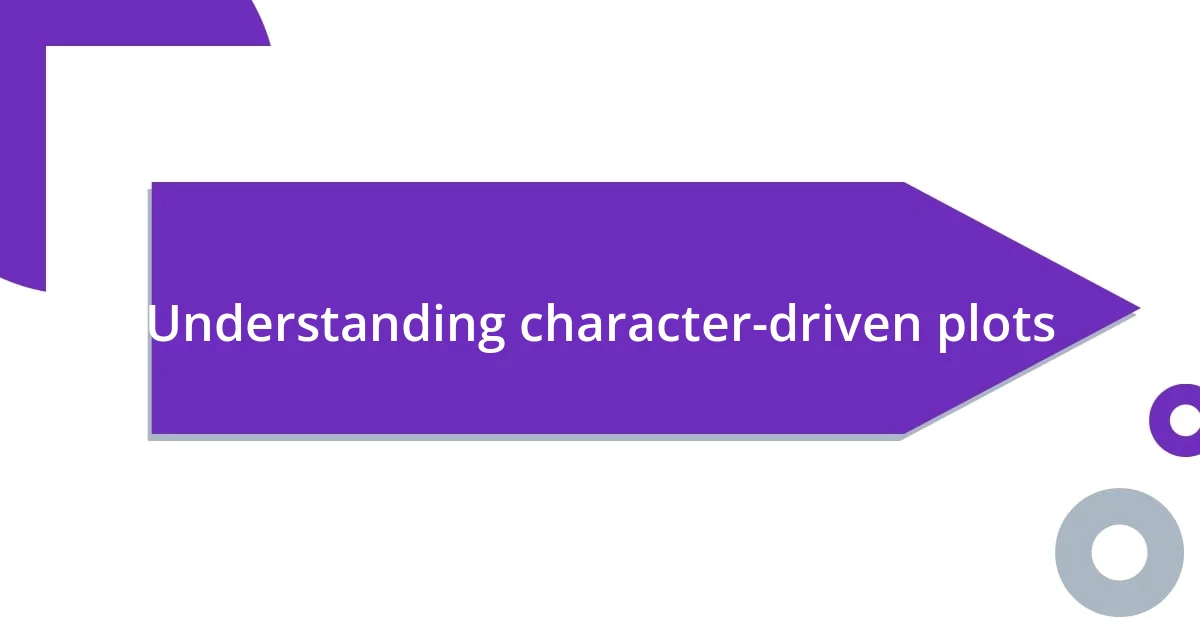
Understanding character-driven plots
Character-driven plots focus on the individuals and their growth rather than the events themselves. When I think about my favorite stories, it’s often the characters’ emotional journeys that draw me in. Do you ever find yourself more invested in how a character evolves than in the actual plot twists?
One memorable example for me is when I read a novel where the protagonist grappled with his past mistakes. Instead of an action-packed sequence, it was his internal struggle that kept me turning pages. This illustrates that, in character-driven plots, the decisions and transformations of characters often resonate more deeply with us than the external conflicts.
In these narratives, every choice a character makes serves to forge their identity, creating a tapestry of motivation and emotion. I remember a time when a story’s character decision mirrored a dilemma I faced in my own life. Such moments remind us that understanding characters’ motivations can be as compelling as understanding the story’s trajectory. Isn’t it fascinating how a well-crafted character can evoke our empathy and reflection?
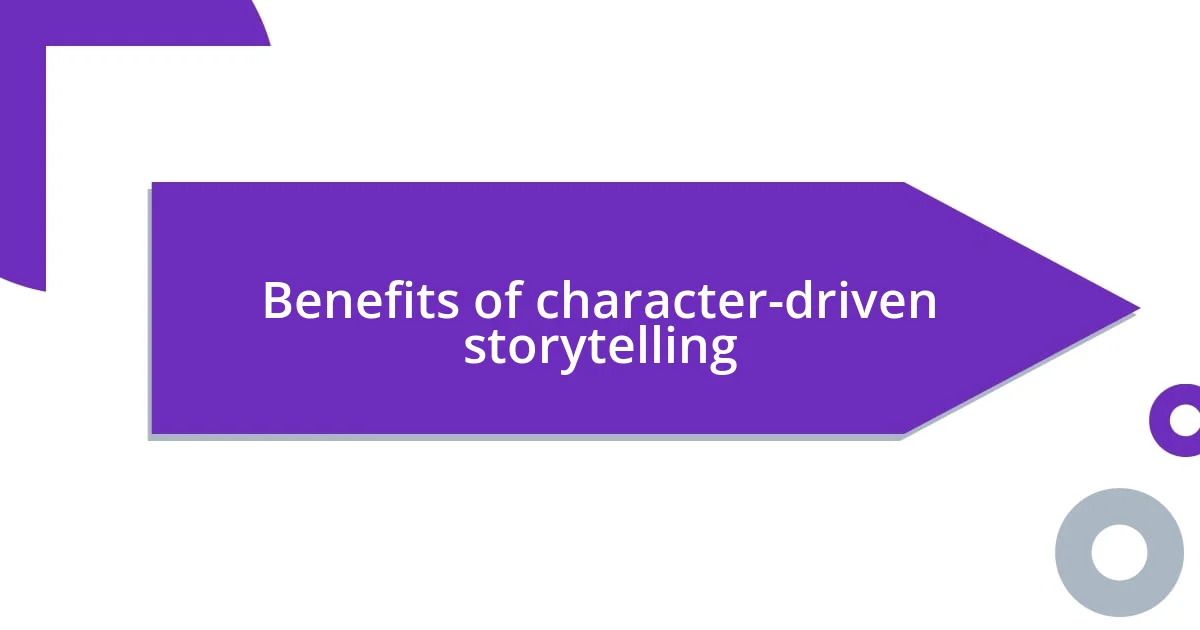
Benefits of character-driven storytelling
Character-driven storytelling brings a wealth of emotional depth that often resonates more profoundly than mere plot mechanics. I’ve found that when the focus shifts to a character’s internal struggles, my investment in their journey grows tenfold. For instance, in a recent book I read, the protagonist faced a moral dilemma that mirrored my own experiences. This level of relatability made each page feel like a reflection of my life, reinforcing the idea that character growth can anchor a reader’s emotional connection to the story.
Moreover, character-driven narratives often create a richer tapestry of themes and perspectives. I remember diving into a series where each character’s backstory unveiled layers of societal issues, prompting me to reflect on the complexities of human nature. It opened my eyes to different perspectives, enhancing my understanding of empathy and connection. Isn’t it amazing how a character’s evolution can challenge your own beliefs and provoke introspection?
Lastly, the flexibility that character-driven plots provide allows for natural and engaging twists. Unlike traditional plots that rely heavily on action, these stories organically develop tension through characters’ relationships and choices. Think back to a film you loved that wasn’t just about the plot but about the interactions between characters. I recall feeling absolutely gripped when a character’s revelation changed their relationship dynamics, showcasing how character development can drive not just drama but also genuine connection.
| Benefit | Description |
|---|---|
| Emotional Connection | Character-driven stories foster deep emotional engagement by focusing on characters’ internal struggles and growth. |
| Rich Themes | These narratives allow the exploration of complex themes and encourage readers to reflect on their lives and beliefs. |
| Natural Tension | Flexibility in character choices leads to organic conflict and organic plot twists that enhance engagement. |
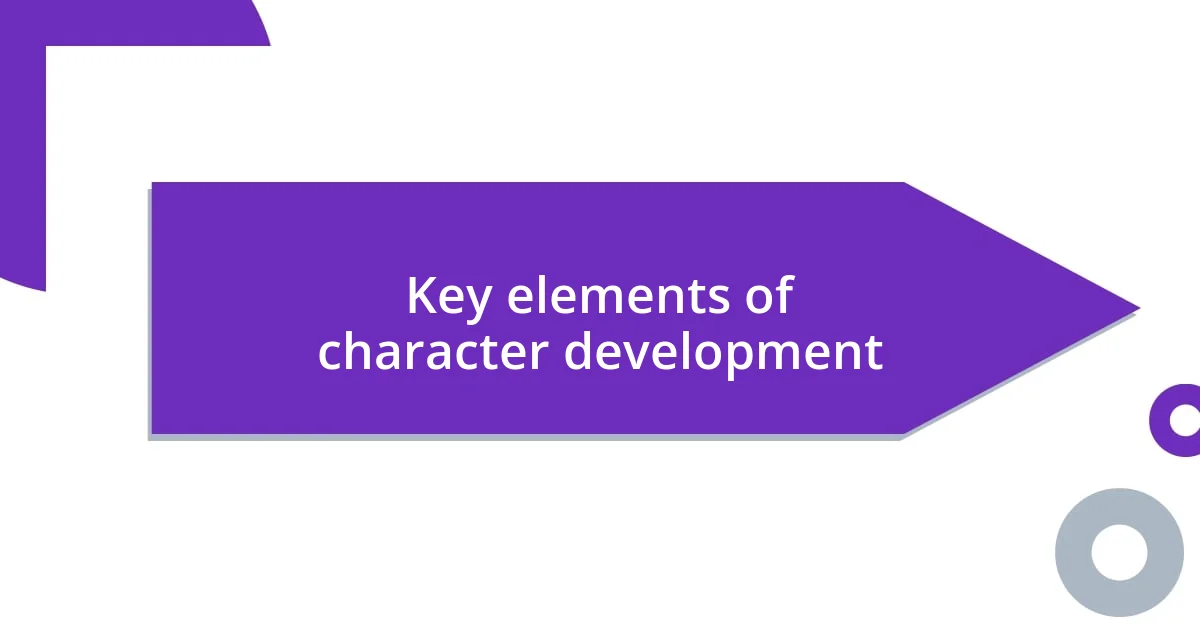
Key elements of character development
Character development is essential for making a story resonate. I’ve always felt that the depth of a character adds layers to the narrative. For instance, consider when a character faces a significant life choice; their background, fears, and desires shape that moment. It’s like peeling back an onion, revealing not just their motivations but also their vulnerabilities.
Here are some key elements to consider for effective character development:
- Backstory: Understanding a character’s past informs their decisions and personality traits.
- Motivation: Every character should have clear desires that drive their actions. This clarity creates relatable conflicts.
- Growth Arc: I appreciate when a character evolves through the story, showcasing authentic transformation due to their experiences.
- Flaws: Flawed characters are relatable. A character wrestling with jealousy or insecurity feels real to me, making their journey more engaging.
When I think about characters who have left an impression on me, it’s often because these elements weave together seamlessly. I remember being particularly drawn to a character who struggled with self-doubt. As she learned to confront her insecurities, I found myself reflecting on my own challenges. This connection is what I believe makes storytelling so powerful.
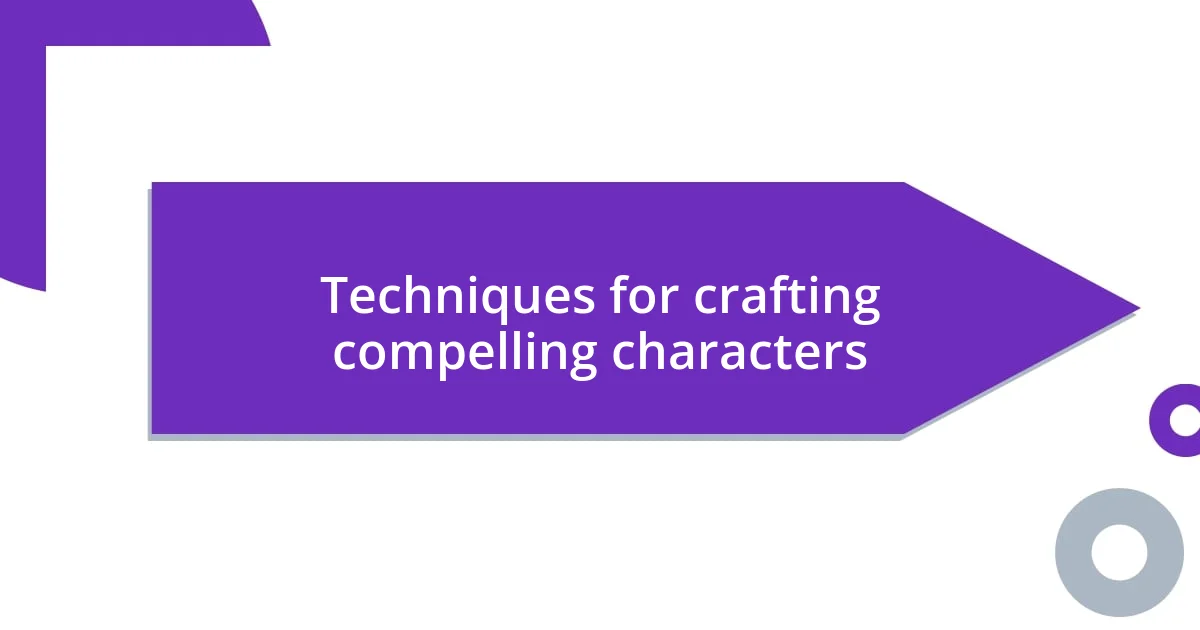
Techniques for crafting compelling characters
Creating compelling characters is an art that involves several nuanced techniques. One method I’ve found particularly effective is to infuse characters with tangible flaws. Take, for example, a novel I recently read where the main character was charming yet deeply insecure. As she navigated her friendships and career, her flaws led to captivating conflicts. This made me wonder—wouldn’t her journey resonate more if I could see a bit of my own imperfections reflected in her struggles?
Another powerful technique is using dialogue to reveal character. I still remember a play where the characters’ conversations were so richly detailed that they painted vivid pictures of their personalities. It wasn’t just what they said but how they interacted. As I listened, I felt like I was peering into their hearts and minds. This makes me ask: how can a writer capture the essence of a character so effortlessly through their words?
Lastly, I believe in the power of symbolism to deepen character significance. In one story, a character’s obsession with her grandmother’s locket represented her need for connection and belonging. Each time she held it, the reader could feel her emotional longing. Isn’t it fascinating how a single object can encapsulate a character’s entire emotional landscape? This technique adds layers, allowing readers to engage on a more intimate level with character motivations.

Balancing plot and character
Balancing plot and character is a delicate dance. I often find myself wondering how to maintain that equilibrium. Too much focus on the plot can lead to a story that feels mechanical, while an overemphasis on character can sometimes make the narrative lag. I recall a book where the plot was thrilling—full of twists and turns—but the characters felt one-dimensional, lacking the dimensions that would have made the stakes feel real to me.
It’s fascinating to think about how character decisions can propel the plot forward. I remember writing a short story where the protagonist’s internal struggle made every choice a pivot point for the narrative. When characters confront their fears, it not only develops them but also advances the plot in unexpected ways. Have you ever read a novel where a character’s growth transformed the direction of the story? That synergy hooks me every time.
In my experience, creating a plot that challenges characters to confront their deepest flaws can lead to powerful storytelling. I once participated in a writing workshop where we explored this concept, crafting stories where conflict wasn’t just external but deeply tied to personal struggle. The results were profound; each character’s journey felt authentic because their challenges came from within. Isn’t it invigorating to watch a character evolve as they tackle both the external plot and internal obstacles?
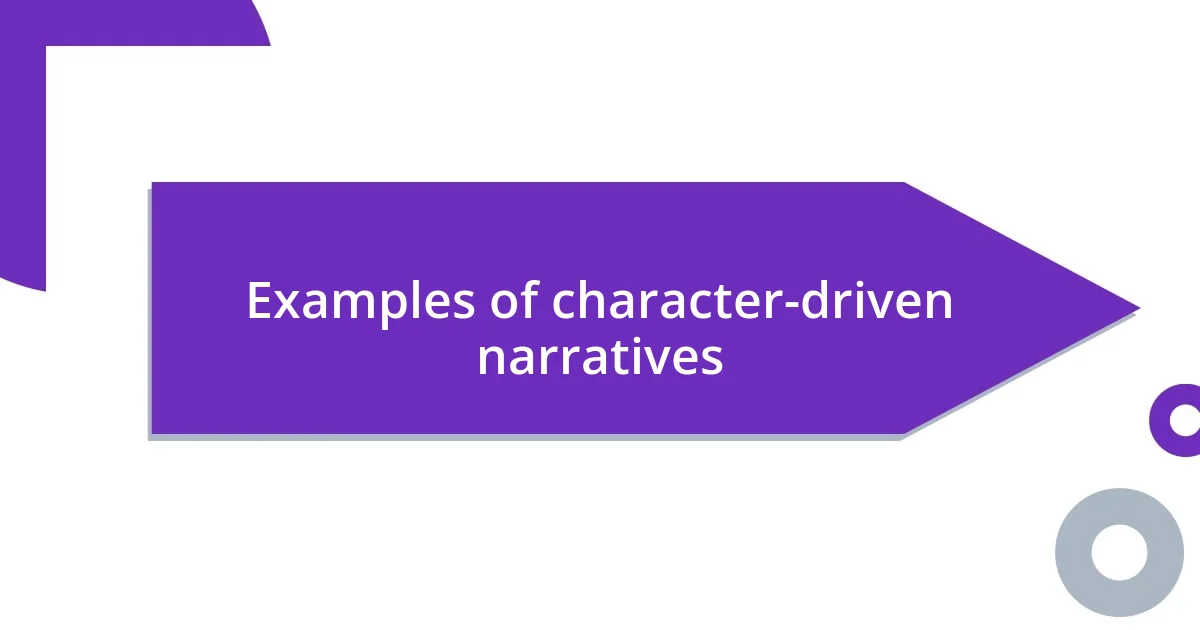
Examples of character-driven narratives
One captivating example of a character-driven narrative that comes to mind is “The Catcher in the Rye.” I still vividly remember the protagonist, Holden Caulfield, whose inner turmoil shapes the entire story. As he grapples with feelings of alienation and loss, his voice feels incredibly authentic, drawing me into his chaotic world. It’s a reminder that sometimes, it’s the character’s emotional journey that stays with us long after we close the book.
Another powerful illustration is “A Man Called Ove” by Fredrik Backman. Ove appears grumpy and misanthropic at first, but as we peel back the layers, I found myself deeply invested in the rich tapestry of his past experiences. Each flashback reveals not just his flaws but also the love and pain that have made him who he is. It made me reflect on how understanding a character’s history can elicit empathy and transform their perceived harshness into something relatable.
In contrast, I think about “The Great Gatsby,” where Gatsby’s unrelenting pursuit of love drives the plot, but his character is what truly captivates. The dreamer in him evokes so much emotion; I felt heartbroken watching him chase an ideal that was never meant to be. Have you ever realized that it’s often the deeply flawed characters that linger in our minds, long after their stories have been told? This highlights why character-driven narratives resonate so profoundly—they reflect the complexities of our own lives.
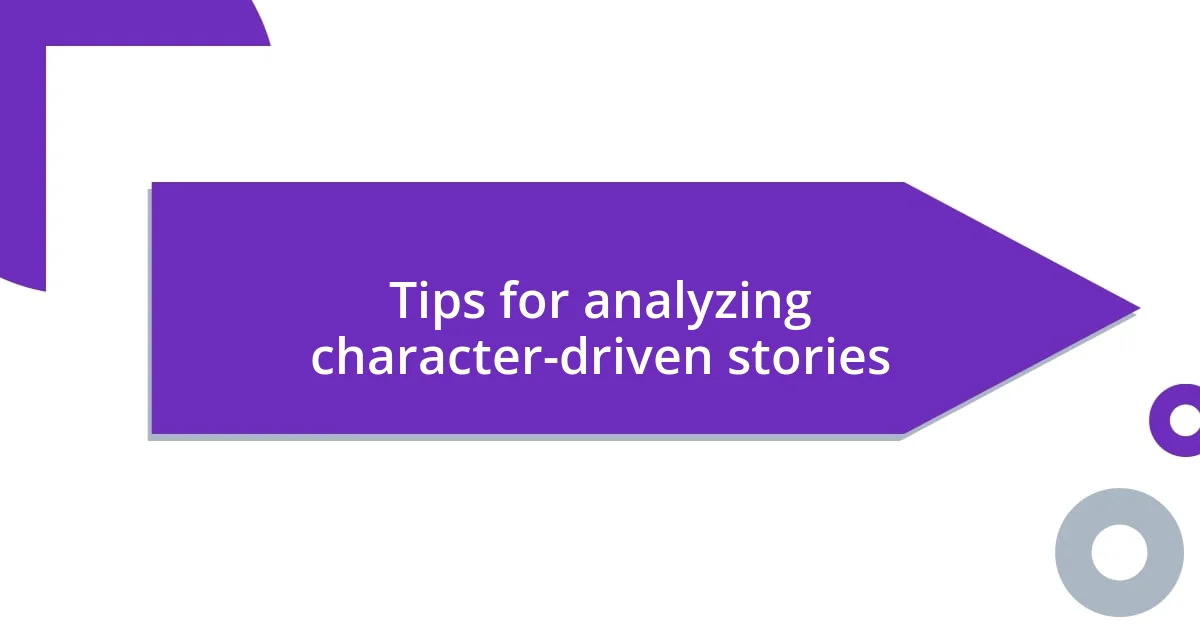
Tips for analyzing character-driven stories
When diving into character-driven stories, pay attention to how characters evolve throughout the narrative. Take the time to think about their motivations and conflicts. I remember being utterly captivated by a novel where the protagonist’s choices revealed her vulnerabilities and growth. Each decision felt significant, and it made me reflect on my own life—how we often grow through our struggles.
Another valuable tip is to notice the relationships between characters. These interactions often highlight their complexities and the story’s emotional depth. I found that analyzing a book where characters fed off one another’s strengths and weaknesses provided greater insight into their development. How do their dynamics drive the plot? Sometimes, tensions within relationships spark the most meaningful conflicts.
Lastly, consider the overarching themes that arise from character journeys. What broader truths do these journeys reveal about human nature? I once analyzed a film where the protagonist’s moral dilemmas challenged my own perspectives on right and wrong. It was enlightening. Isn’t it fascinating how character-driven narratives can evoke introspection and connect us to universal experiences? By reflecting on these elements, you can gain a richer understanding of the story’s impact.














